Taxation Law MA613 Semester 2 Assignment: Small Business Concessions
VerifiedAdded on 2022/11/17
|11
|2971
|72
Homework Assignment
AI Summary
This taxation law assignment delves into the intricacies of small business entity (SBE) concessions, providing a comprehensive overview of the relevant tax regulations and their implications. The assignment explores the definition of SBEs, outlining the criteria for eligibility based on aggregate turnover and business activities, as per ATO guidelines. It analyzes the favorable treatment given to SBEs, focusing on the minimization of compliance costs and tax liabilities, and the government's preferential approach to support growth and innovation in the small business sector. The assignment also examines the significance of SBE concessions, particularly in relation to Capital Gains Tax (CGT), including the 50% and 100% deductions available on active assets and the benefits of careful tax planning. Furthermore, it covers simplified depreciation rules, trading stock regulations, and recent developments like the Single Touch Payroll (STP) system and instant asset write-off thresholds. Case laws and government policies are discussed to illustrate the practical application of these tax provisions, offering insights into the advantages and challenges faced by small businesses in the context of taxation law.
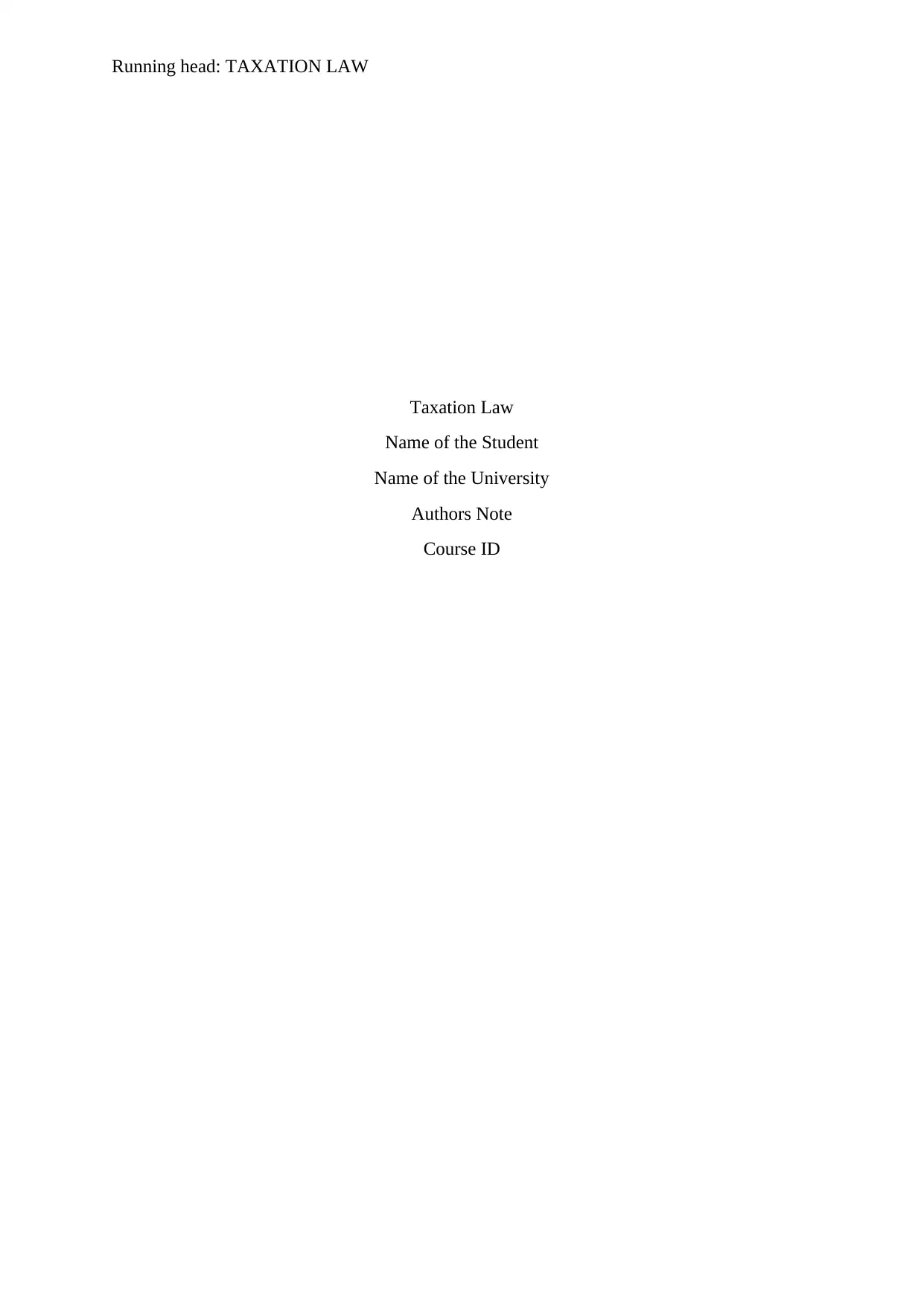
Running head: TAXATION LAW
Taxation Law
Name of the Student
Name of the University
Authors Note
Course ID
Taxation Law
Name of the Student
Name of the University
Authors Note
Course ID
Paraphrase This Document
Need a fresh take? Get an instant paraphrase of this document with our AI Paraphraser
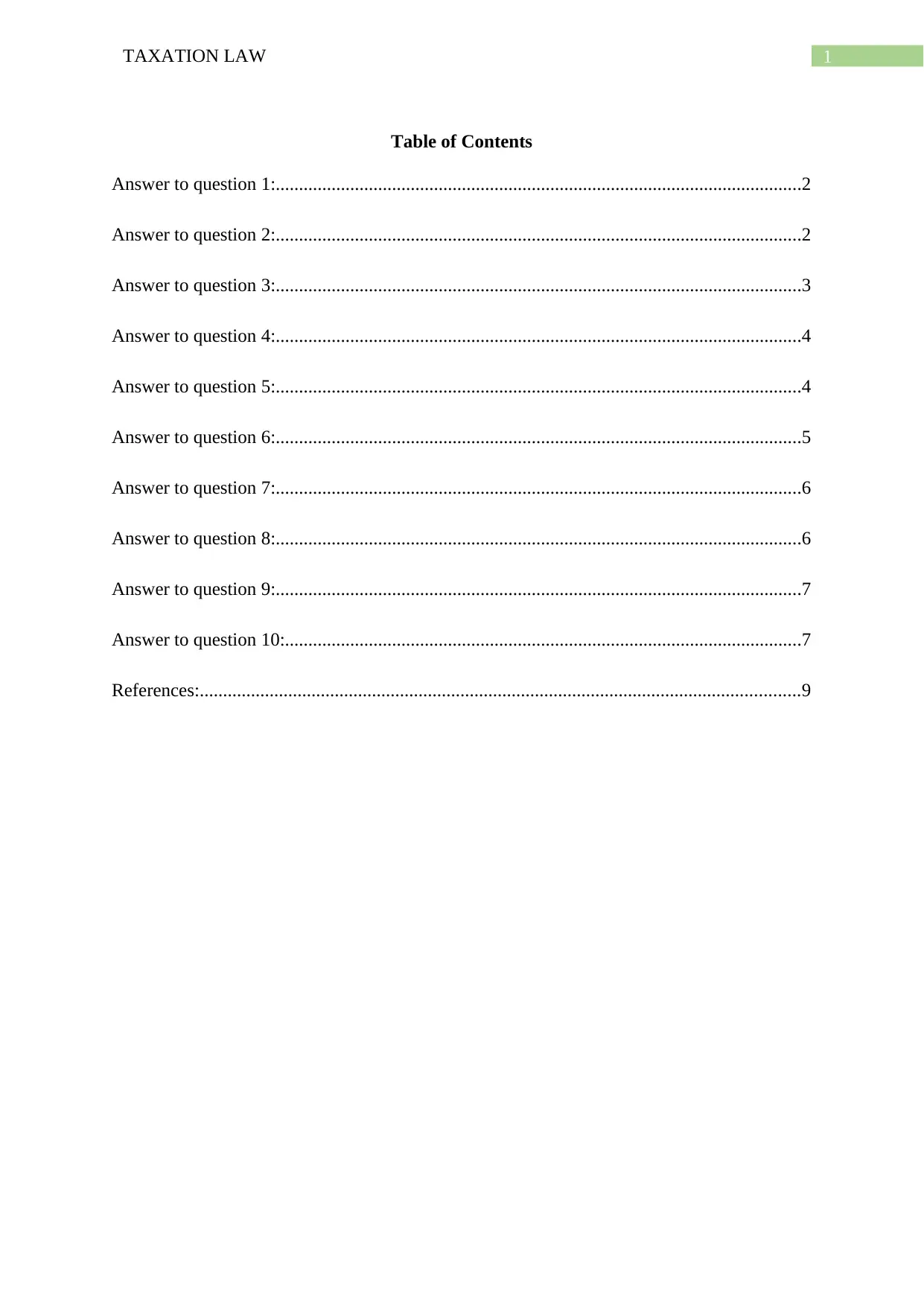
1TAXATION LAW
Table of Contents
Answer to question 1:.................................................................................................................2
Answer to question 2:.................................................................................................................2
Answer to question 3:.................................................................................................................3
Answer to question 4:.................................................................................................................4
Answer to question 5:.................................................................................................................4
Answer to question 6:.................................................................................................................5
Answer to question 7:.................................................................................................................6
Answer to question 8:.................................................................................................................6
Answer to question 9:.................................................................................................................7
Answer to question 10:...............................................................................................................7
References:.................................................................................................................................9
Table of Contents
Answer to question 1:.................................................................................................................2
Answer to question 2:.................................................................................................................2
Answer to question 3:.................................................................................................................3
Answer to question 4:.................................................................................................................4
Answer to question 5:.................................................................................................................4
Answer to question 6:.................................................................................................................5
Answer to question 7:.................................................................................................................6
Answer to question 8:.................................................................................................................6
Answer to question 9:.................................................................................................................7
Answer to question 10:...............................................................................................................7
References:.................................................................................................................................9
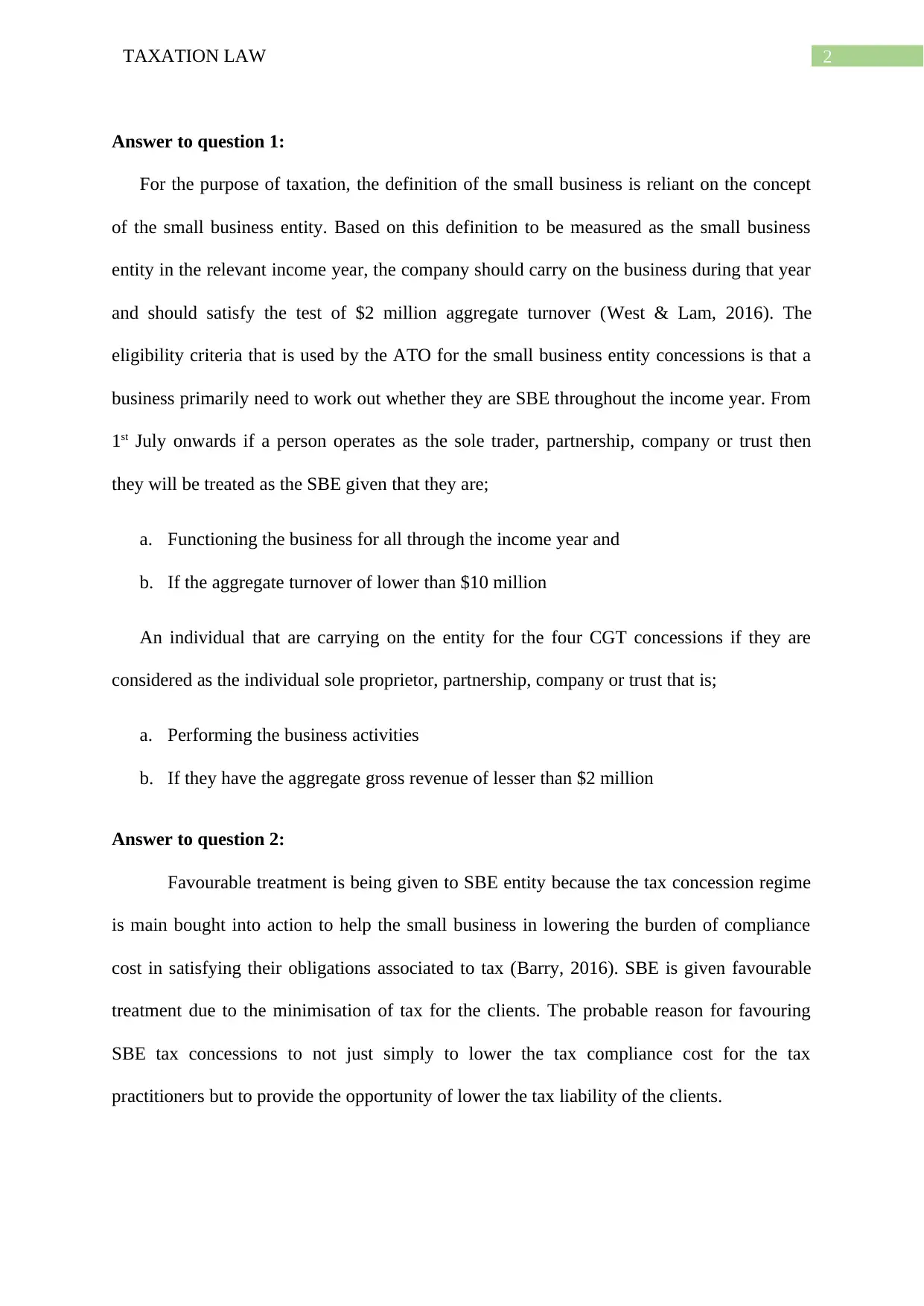
2TAXATION LAW
Answer to question 1:
For the purpose of taxation, the definition of the small business is reliant on the concept
of the small business entity. Based on this definition to be measured as the small business
entity in the relevant income year, the company should carry on the business during that year
and should satisfy the test of $2 million aggregate turnover (West & Lam, 2016). The
eligibility criteria that is used by the ATO for the small business entity concessions is that a
business primarily need to work out whether they are SBE throughout the income year. From
1st July onwards if a person operates as the sole trader, partnership, company or trust then
they will be treated as the SBE given that they are;
a. Functioning the business for all through the income year and
b. If the aggregate turnover of lower than $10 million
An individual that are carrying on the entity for the four CGT concessions if they are
considered as the individual sole proprietor, partnership, company or trust that is;
a. Performing the business activities
b. If they have the aggregate gross revenue of lesser than $2 million
Answer to question 2:
Favourable treatment is being given to SBE entity because the tax concession regime
is main bought into action to help the small business in lowering the burden of compliance
cost in satisfying their obligations associated to tax (Barry, 2016). SBE is given favourable
treatment due to the minimisation of tax for the clients. The probable reason for favouring
SBE tax concessions to not just simply to lower the tax compliance cost for the tax
practitioners but to provide the opportunity of lower the tax liability of the clients.
Answer to question 1:
For the purpose of taxation, the definition of the small business is reliant on the concept
of the small business entity. Based on this definition to be measured as the small business
entity in the relevant income year, the company should carry on the business during that year
and should satisfy the test of $2 million aggregate turnover (West & Lam, 2016). The
eligibility criteria that is used by the ATO for the small business entity concessions is that a
business primarily need to work out whether they are SBE throughout the income year. From
1st July onwards if a person operates as the sole trader, partnership, company or trust then
they will be treated as the SBE given that they are;
a. Functioning the business for all through the income year and
b. If the aggregate turnover of lower than $10 million
An individual that are carrying on the entity for the four CGT concessions if they are
considered as the individual sole proprietor, partnership, company or trust that is;
a. Performing the business activities
b. If they have the aggregate gross revenue of lesser than $2 million
Answer to question 2:
Favourable treatment is being given to SBE entity because the tax concession regime
is main bought into action to help the small business in lowering the burden of compliance
cost in satisfying their obligations associated to tax (Barry, 2016). SBE is given favourable
treatment due to the minimisation of tax for the clients. The probable reason for favouring
SBE tax concessions to not just simply to lower the tax compliance cost for the tax
practitioners but to provide the opportunity of lower the tax liability of the clients.
⊘ This is a preview!⊘
Do you want full access?
Subscribe today to unlock all pages.

Trusted by 1+ million students worldwide
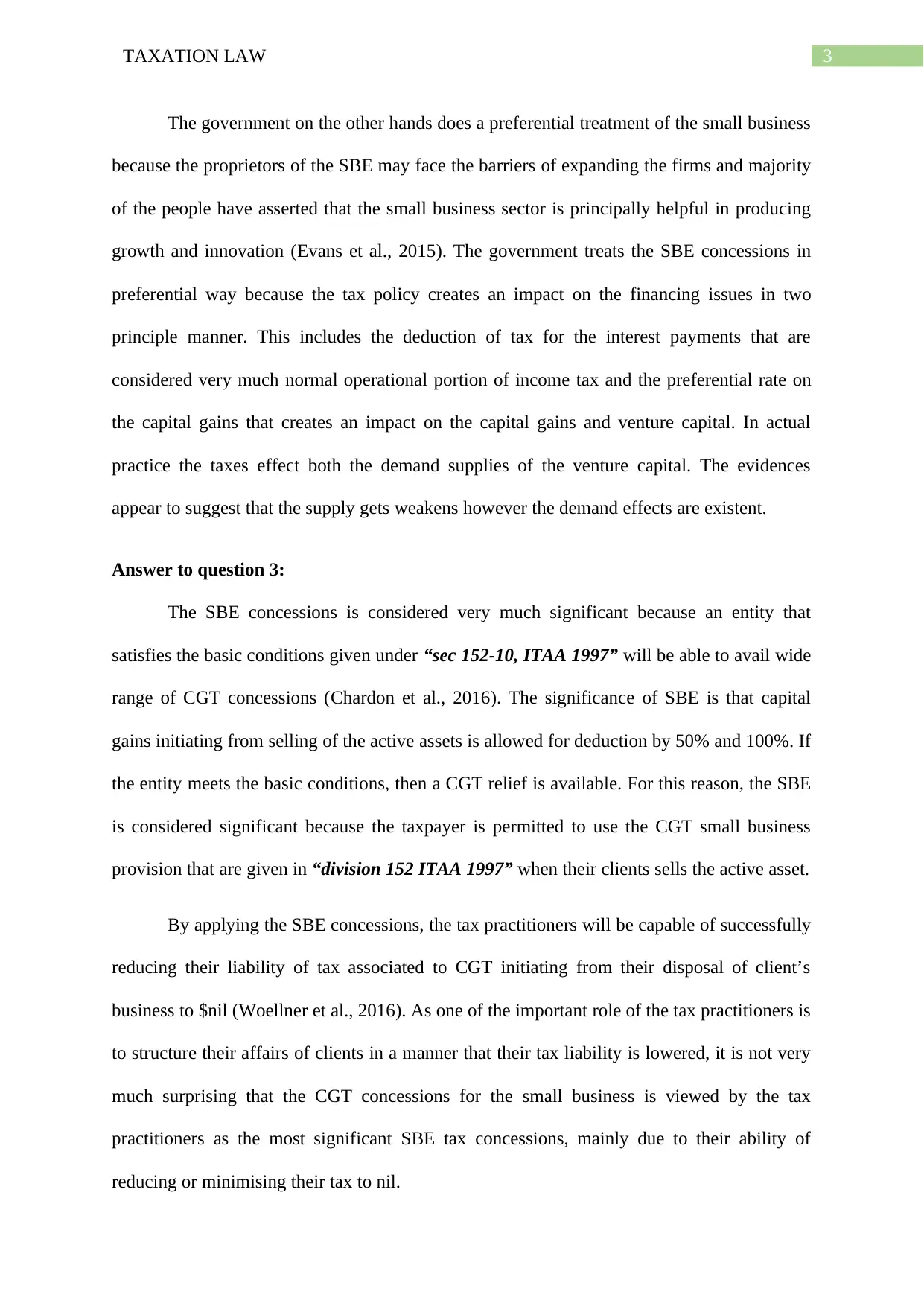
3TAXATION LAW
The government on the other hands does a preferential treatment of the small business
because the proprietors of the SBE may face the barriers of expanding the firms and majority
of the people have asserted that the small business sector is principally helpful in producing
growth and innovation (Evans et al., 2015). The government treats the SBE concessions in
preferential way because the tax policy creates an impact on the financing issues in two
principle manner. This includes the deduction of tax for the interest payments that are
considered very much normal operational portion of income tax and the preferential rate on
the capital gains that creates an impact on the capital gains and venture capital. In actual
practice the taxes effect both the demand supplies of the venture capital. The evidences
appear to suggest that the supply gets weakens however the demand effects are existent.
Answer to question 3:
The SBE concessions is considered very much significant because an entity that
satisfies the basic conditions given under “sec 152-10, ITAA 1997” will be able to avail wide
range of CGT concessions (Chardon et al., 2016). The significance of SBE is that capital
gains initiating from selling of the active assets is allowed for deduction by 50% and 100%. If
the entity meets the basic conditions, then a CGT relief is available. For this reason, the SBE
is considered significant because the taxpayer is permitted to use the CGT small business
provision that are given in “division 152 ITAA 1997” when their clients sells the active asset.
By applying the SBE concessions, the tax practitioners will be capable of successfully
reducing their liability of tax associated to CGT initiating from their disposal of client’s
business to $nil (Woellner et al., 2016). As one of the important role of the tax practitioners is
to structure their affairs of clients in a manner that their tax liability is lowered, it is not very
much surprising that the CGT concessions for the small business is viewed by the tax
practitioners as the most significant SBE tax concessions, mainly due to their ability of
reducing or minimising their tax to nil.
The government on the other hands does a preferential treatment of the small business
because the proprietors of the SBE may face the barriers of expanding the firms and majority
of the people have asserted that the small business sector is principally helpful in producing
growth and innovation (Evans et al., 2015). The government treats the SBE concessions in
preferential way because the tax policy creates an impact on the financing issues in two
principle manner. This includes the deduction of tax for the interest payments that are
considered very much normal operational portion of income tax and the preferential rate on
the capital gains that creates an impact on the capital gains and venture capital. In actual
practice the taxes effect both the demand supplies of the venture capital. The evidences
appear to suggest that the supply gets weakens however the demand effects are existent.
Answer to question 3:
The SBE concessions is considered very much significant because an entity that
satisfies the basic conditions given under “sec 152-10, ITAA 1997” will be able to avail wide
range of CGT concessions (Chardon et al., 2016). The significance of SBE is that capital
gains initiating from selling of the active assets is allowed for deduction by 50% and 100%. If
the entity meets the basic conditions, then a CGT relief is available. For this reason, the SBE
is considered significant because the taxpayer is permitted to use the CGT small business
provision that are given in “division 152 ITAA 1997” when their clients sells the active asset.
By applying the SBE concessions, the tax practitioners will be capable of successfully
reducing their liability of tax associated to CGT initiating from their disposal of client’s
business to $nil (Woellner et al., 2016). As one of the important role of the tax practitioners is
to structure their affairs of clients in a manner that their tax liability is lowered, it is not very
much surprising that the CGT concessions for the small business is viewed by the tax
practitioners as the most significant SBE tax concessions, mainly due to their ability of
reducing or minimising their tax to nil.
Paraphrase This Document
Need a fresh take? Get an instant paraphrase of this document with our AI Paraphraser
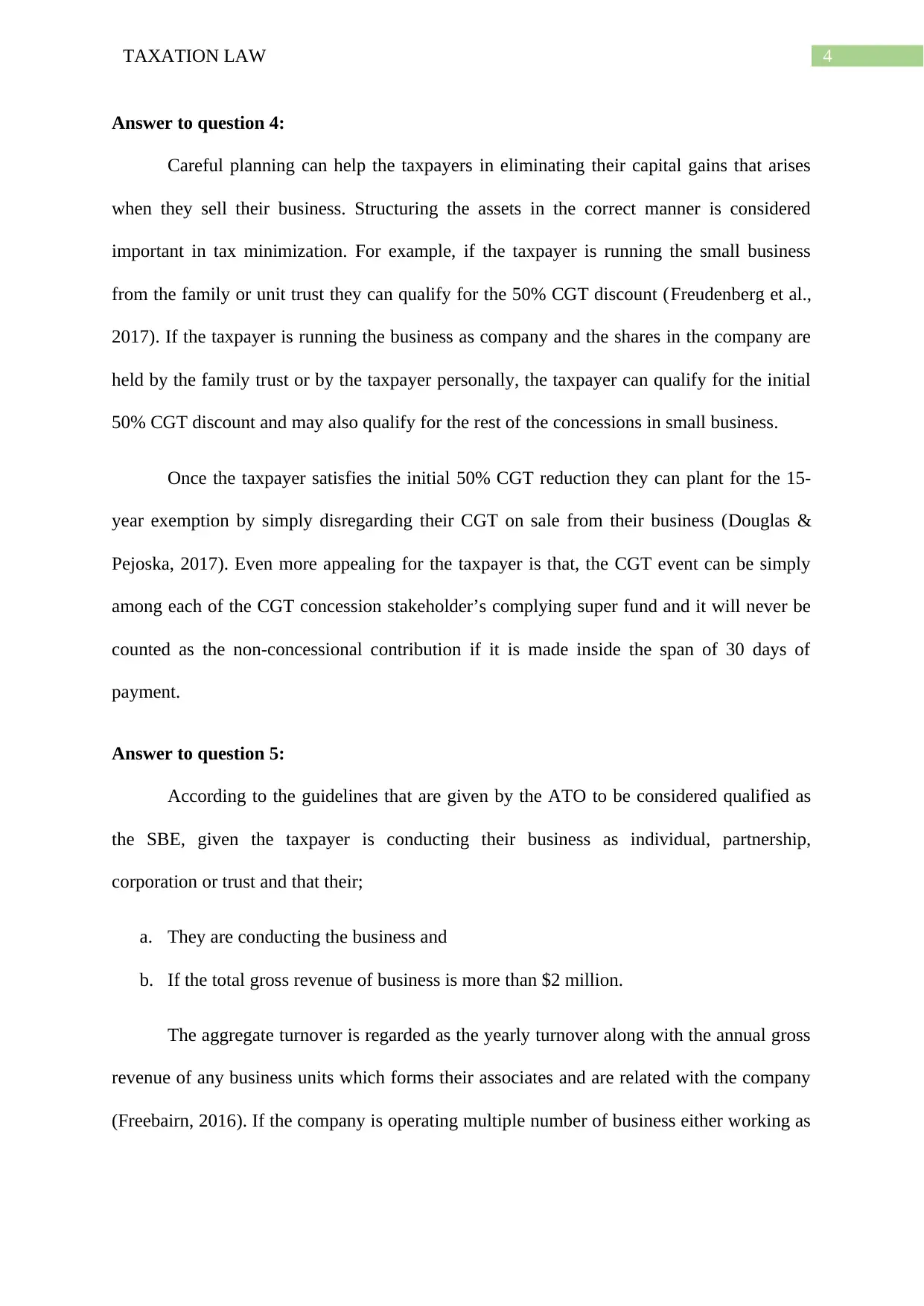
4TAXATION LAW
Answer to question 4:
Careful planning can help the taxpayers in eliminating their capital gains that arises
when they sell their business. Structuring the assets in the correct manner is considered
important in tax minimization. For example, if the taxpayer is running the small business
from the family or unit trust they can qualify for the 50% CGT discount (Freudenberg et al.,
2017). If the taxpayer is running the business as company and the shares in the company are
held by the family trust or by the taxpayer personally, the taxpayer can qualify for the initial
50% CGT discount and may also qualify for the rest of the concessions in small business.
Once the taxpayer satisfies the initial 50% CGT reduction they can plant for the 15-
year exemption by simply disregarding their CGT on sale from their business (Douglas &
Pejoska, 2017). Even more appealing for the taxpayer is that, the CGT event can be simply
among each of the CGT concession stakeholder’s complying super fund and it will never be
counted as the non-concessional contribution if it is made inside the span of 30 days of
payment.
Answer to question 5:
According to the guidelines that are given by the ATO to be considered qualified as
the SBE, given the taxpayer is conducting their business as individual, partnership,
corporation or trust and that their;
a. They are conducting the business and
b. If the total gross revenue of business is more than $2 million.
The aggregate turnover is regarded as the yearly turnover along with the annual gross
revenue of any business units which forms their associates and are related with the company
(Freebairn, 2016). If the company is operating multiple number of business either working as
Answer to question 4:
Careful planning can help the taxpayers in eliminating their capital gains that arises
when they sell their business. Structuring the assets in the correct manner is considered
important in tax minimization. For example, if the taxpayer is running the small business
from the family or unit trust they can qualify for the 50% CGT discount (Freudenberg et al.,
2017). If the taxpayer is running the business as company and the shares in the company are
held by the family trust or by the taxpayer personally, the taxpayer can qualify for the initial
50% CGT discount and may also qualify for the rest of the concessions in small business.
Once the taxpayer satisfies the initial 50% CGT reduction they can plant for the 15-
year exemption by simply disregarding their CGT on sale from their business (Douglas &
Pejoska, 2017). Even more appealing for the taxpayer is that, the CGT event can be simply
among each of the CGT concession stakeholder’s complying super fund and it will never be
counted as the non-concessional contribution if it is made inside the span of 30 days of
payment.
Answer to question 5:
According to the guidelines that are given by the ATO to be considered qualified as
the SBE, given the taxpayer is conducting their business as individual, partnership,
corporation or trust and that their;
a. They are conducting the business and
b. If the total gross revenue of business is more than $2 million.
The aggregate turnover is regarded as the yearly turnover along with the annual gross
revenue of any business units which forms their associates and are related with the company
(Freebairn, 2016). If the company is operating multiple number of business either working as
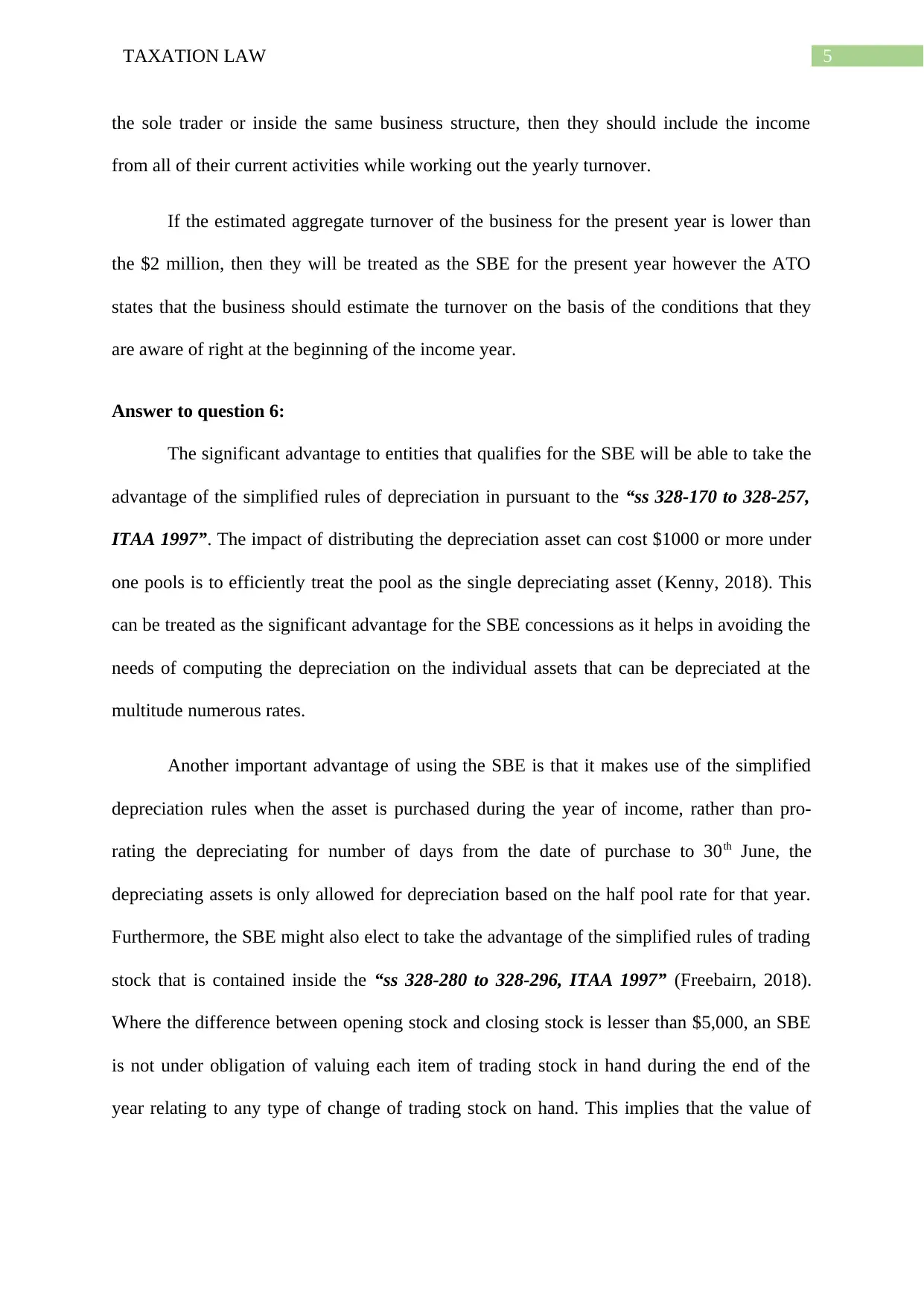
5TAXATION LAW
the sole trader or inside the same business structure, then they should include the income
from all of their current activities while working out the yearly turnover.
If the estimated aggregate turnover of the business for the present year is lower than
the $2 million, then they will be treated as the SBE for the present year however the ATO
states that the business should estimate the turnover on the basis of the conditions that they
are aware of right at the beginning of the income year.
Answer to question 6:
The significant advantage to entities that qualifies for the SBE will be able to take the
advantage of the simplified rules of depreciation in pursuant to the “ss 328-170 to 328-257,
ITAA 1997”. The impact of distributing the depreciation asset can cost $1000 or more under
one pools is to efficiently treat the pool as the single depreciating asset (Kenny, 2018). This
can be treated as the significant advantage for the SBE concessions as it helps in avoiding the
needs of computing the depreciation on the individual assets that can be depreciated at the
multitude numerous rates.
Another important advantage of using the SBE is that it makes use of the simplified
depreciation rules when the asset is purchased during the year of income, rather than pro-
rating the depreciating for number of days from the date of purchase to 30th June, the
depreciating assets is only allowed for depreciation based on the half pool rate for that year.
Furthermore, the SBE might also elect to take the advantage of the simplified rules of trading
stock that is contained inside the “ss 328-280 to 328-296, ITAA 1997” (Freebairn, 2018).
Where the difference between opening stock and closing stock is lesser than $5,000, an SBE
is not under obligation of valuing each item of trading stock in hand during the end of the
year relating to any type of change of trading stock on hand. This implies that the value of
the sole trader or inside the same business structure, then they should include the income
from all of their current activities while working out the yearly turnover.
If the estimated aggregate turnover of the business for the present year is lower than
the $2 million, then they will be treated as the SBE for the present year however the ATO
states that the business should estimate the turnover on the basis of the conditions that they
are aware of right at the beginning of the income year.
Answer to question 6:
The significant advantage to entities that qualifies for the SBE will be able to take the
advantage of the simplified rules of depreciation in pursuant to the “ss 328-170 to 328-257,
ITAA 1997”. The impact of distributing the depreciation asset can cost $1000 or more under
one pools is to efficiently treat the pool as the single depreciating asset (Kenny, 2018). This
can be treated as the significant advantage for the SBE concessions as it helps in avoiding the
needs of computing the depreciation on the individual assets that can be depreciated at the
multitude numerous rates.
Another important advantage of using the SBE is that it makes use of the simplified
depreciation rules when the asset is purchased during the year of income, rather than pro-
rating the depreciating for number of days from the date of purchase to 30th June, the
depreciating assets is only allowed for depreciation based on the half pool rate for that year.
Furthermore, the SBE might also elect to take the advantage of the simplified rules of trading
stock that is contained inside the “ss 328-280 to 328-296, ITAA 1997” (Freebairn, 2018).
Where the difference between opening stock and closing stock is lesser than $5,000, an SBE
is not under obligation of valuing each item of trading stock in hand during the end of the
year relating to any type of change of trading stock on hand. This implies that the value of
⊘ This is a preview!⊘
Do you want full access?
Subscribe today to unlock all pages.

Trusted by 1+ million students worldwide
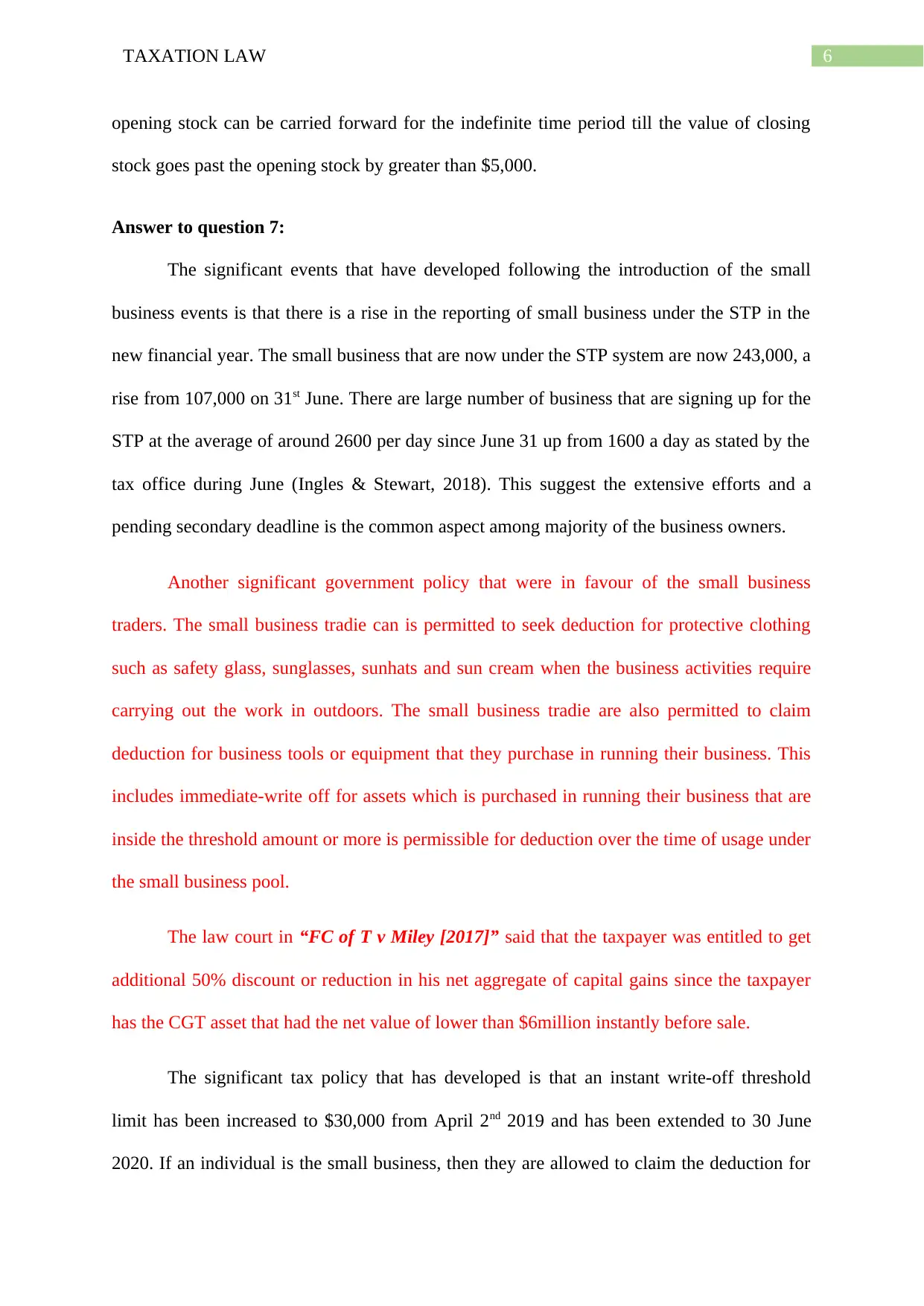
6TAXATION LAW
opening stock can be carried forward for the indefinite time period till the value of closing
stock goes past the opening stock by greater than $5,000.
Answer to question 7:
The significant events that have developed following the introduction of the small
business events is that there is a rise in the reporting of small business under the STP in the
new financial year. The small business that are now under the STP system are now 243,000, a
rise from 107,000 on 31st June. There are large number of business that are signing up for the
STP at the average of around 2600 per day since June 31 up from 1600 a day as stated by the
tax office during June (Ingles & Stewart, 2018). This suggest the extensive efforts and a
pending secondary deadline is the common aspect among majority of the business owners.
Another significant government policy that were in favour of the small business
traders. The small business tradie can is permitted to seek deduction for protective clothing
such as safety glass, sunglasses, sunhats and sun cream when the business activities require
carrying out the work in outdoors. The small business tradie are also permitted to claim
deduction for business tools or equipment that they purchase in running their business. This
includes immediate-write off for assets which is purchased in running their business that are
inside the threshold amount or more is permissible for deduction over the time of usage under
the small business pool.
The law court in “FC of T v Miley [2017]” said that the taxpayer was entitled to get
additional 50% discount or reduction in his net aggregate of capital gains since the taxpayer
has the CGT asset that had the net value of lower than $6million instantly before sale.
The significant tax policy that has developed is that an instant write-off threshold
limit has been increased to $30,000 from April 2nd 2019 and has been extended to 30 June
2020. If an individual is the small business, then they are allowed to claim the deduction for
opening stock can be carried forward for the indefinite time period till the value of closing
stock goes past the opening stock by greater than $5,000.
Answer to question 7:
The significant events that have developed following the introduction of the small
business events is that there is a rise in the reporting of small business under the STP in the
new financial year. The small business that are now under the STP system are now 243,000, a
rise from 107,000 on 31st June. There are large number of business that are signing up for the
STP at the average of around 2600 per day since June 31 up from 1600 a day as stated by the
tax office during June (Ingles & Stewart, 2018). This suggest the extensive efforts and a
pending secondary deadline is the common aspect among majority of the business owners.
Another significant government policy that were in favour of the small business
traders. The small business tradie can is permitted to seek deduction for protective clothing
such as safety glass, sunglasses, sunhats and sun cream when the business activities require
carrying out the work in outdoors. The small business tradie are also permitted to claim
deduction for business tools or equipment that they purchase in running their business. This
includes immediate-write off for assets which is purchased in running their business that are
inside the threshold amount or more is permissible for deduction over the time of usage under
the small business pool.
The law court in “FC of T v Miley [2017]” said that the taxpayer was entitled to get
additional 50% discount or reduction in his net aggregate of capital gains since the taxpayer
has the CGT asset that had the net value of lower than $6million instantly before sale.
The significant tax policy that has developed is that an instant write-off threshold
limit has been increased to $30,000 from April 2nd 2019 and has been extended to 30 June
2020. If an individual is the small business, then they are allowed to claim the deduction for
Paraphrase This Document
Need a fresh take? Get an instant paraphrase of this document with our AI Paraphraser
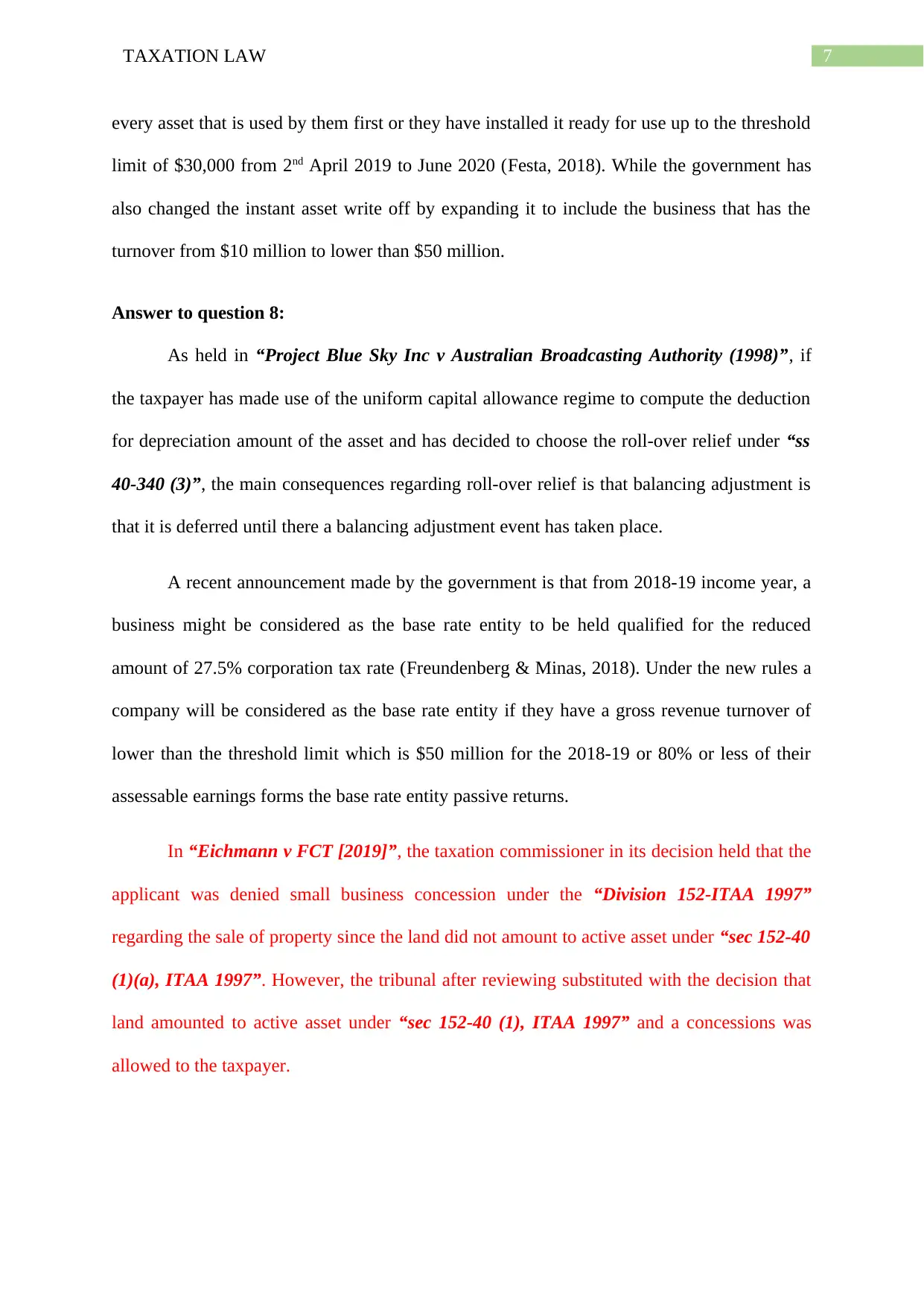
7TAXATION LAW
every asset that is used by them first or they have installed it ready for use up to the threshold
limit of $30,000 from 2nd April 2019 to June 2020 (Festa, 2018). While the government has
also changed the instant asset write off by expanding it to include the business that has the
turnover from $10 million to lower than $50 million.
Answer to question 8:
As held in “Project Blue Sky Inc v Australian Broadcasting Authority (1998)”, if
the taxpayer has made use of the uniform capital allowance regime to compute the deduction
for depreciation amount of the asset and has decided to choose the roll-over relief under “ss
40-340 (3)”, the main consequences regarding roll-over relief is that balancing adjustment is
that it is deferred until there a balancing adjustment event has taken place.
A recent announcement made by the government is that from 2018-19 income year, a
business might be considered as the base rate entity to be held qualified for the reduced
amount of 27.5% corporation tax rate (Freundenberg & Minas, 2018). Under the new rules a
company will be considered as the base rate entity if they have a gross revenue turnover of
lower than the threshold limit which is $50 million for the 2018-19 or 80% or less of their
assessable earnings forms the base rate entity passive returns.
In “Eichmann v FCT [2019]”, the taxation commissioner in its decision held that the
applicant was denied small business concession under the “Division 152-ITAA 1997”
regarding the sale of property since the land did not amount to active asset under “sec 152-40
(1)(a), ITAA 1997”. However, the tribunal after reviewing substituted with the decision that
land amounted to active asset under “sec 152-40 (1), ITAA 1997” and a concessions was
allowed to the taxpayer.
every asset that is used by them first or they have installed it ready for use up to the threshold
limit of $30,000 from 2nd April 2019 to June 2020 (Festa, 2018). While the government has
also changed the instant asset write off by expanding it to include the business that has the
turnover from $10 million to lower than $50 million.
Answer to question 8:
As held in “Project Blue Sky Inc v Australian Broadcasting Authority (1998)”, if
the taxpayer has made use of the uniform capital allowance regime to compute the deduction
for depreciation amount of the asset and has decided to choose the roll-over relief under “ss
40-340 (3)”, the main consequences regarding roll-over relief is that balancing adjustment is
that it is deferred until there a balancing adjustment event has taken place.
A recent announcement made by the government is that from 2018-19 income year, a
business might be considered as the base rate entity to be held qualified for the reduced
amount of 27.5% corporation tax rate (Freundenberg & Minas, 2018). Under the new rules a
company will be considered as the base rate entity if they have a gross revenue turnover of
lower than the threshold limit which is $50 million for the 2018-19 or 80% or less of their
assessable earnings forms the base rate entity passive returns.
In “Eichmann v FCT [2019]”, the taxation commissioner in its decision held that the
applicant was denied small business concession under the “Division 152-ITAA 1997”
regarding the sale of property since the land did not amount to active asset under “sec 152-40
(1)(a), ITAA 1997”. However, the tribunal after reviewing substituted with the decision that
land amounted to active asset under “sec 152-40 (1), ITAA 1997” and a concessions was
allowed to the taxpayer.
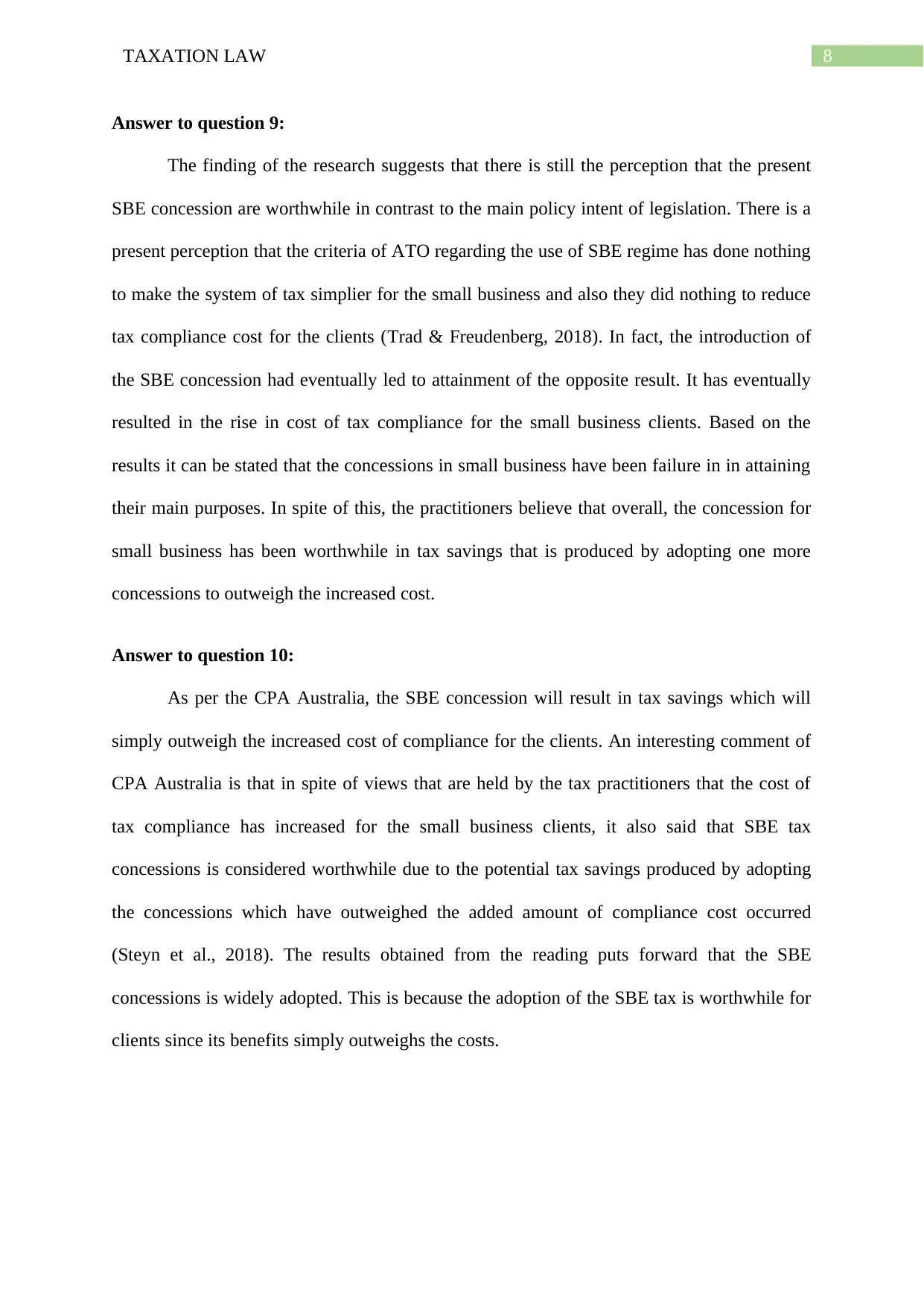
8TAXATION LAW
Answer to question 9:
The finding of the research suggests that there is still the perception that the present
SBE concession are worthwhile in contrast to the main policy intent of legislation. There is a
present perception that the criteria of ATO regarding the use of SBE regime has done nothing
to make the system of tax simplier for the small business and also they did nothing to reduce
tax compliance cost for the clients (Trad & Freudenberg, 2018). In fact, the introduction of
the SBE concession had eventually led to attainment of the opposite result. It has eventually
resulted in the rise in cost of tax compliance for the small business clients. Based on the
results it can be stated that the concessions in small business have been failure in in attaining
their main purposes. In spite of this, the practitioners believe that overall, the concession for
small business has been worthwhile in tax savings that is produced by adopting one more
concessions to outweigh the increased cost.
Answer to question 10:
As per the CPA Australia, the SBE concession will result in tax savings which will
simply outweigh the increased cost of compliance for the clients. An interesting comment of
CPA Australia is that in spite of views that are held by the tax practitioners that the cost of
tax compliance has increased for the small business clients, it also said that SBE tax
concessions is considered worthwhile due to the potential tax savings produced by adopting
the concessions which have outweighed the added amount of compliance cost occurred
(Steyn et al., 2018). The results obtained from the reading puts forward that the SBE
concessions is widely adopted. This is because the adoption of the SBE tax is worthwhile for
clients since its benefits simply outweighs the costs.
Answer to question 9:
The finding of the research suggests that there is still the perception that the present
SBE concession are worthwhile in contrast to the main policy intent of legislation. There is a
present perception that the criteria of ATO regarding the use of SBE regime has done nothing
to make the system of tax simplier for the small business and also they did nothing to reduce
tax compliance cost for the clients (Trad & Freudenberg, 2018). In fact, the introduction of
the SBE concession had eventually led to attainment of the opposite result. It has eventually
resulted in the rise in cost of tax compliance for the small business clients. Based on the
results it can be stated that the concessions in small business have been failure in in attaining
their main purposes. In spite of this, the practitioners believe that overall, the concession for
small business has been worthwhile in tax savings that is produced by adopting one more
concessions to outweigh the increased cost.
Answer to question 10:
As per the CPA Australia, the SBE concession will result in tax savings which will
simply outweigh the increased cost of compliance for the clients. An interesting comment of
CPA Australia is that in spite of views that are held by the tax practitioners that the cost of
tax compliance has increased for the small business clients, it also said that SBE tax
concessions is considered worthwhile due to the potential tax savings produced by adopting
the concessions which have outweighed the added amount of compliance cost occurred
(Steyn et al., 2018). The results obtained from the reading puts forward that the SBE
concessions is widely adopted. This is because the adoption of the SBE tax is worthwhile for
clients since its benefits simply outweighs the costs.
⊘ This is a preview!⊘
Do you want full access?
Subscribe today to unlock all pages.

Trusted by 1+ million students worldwide
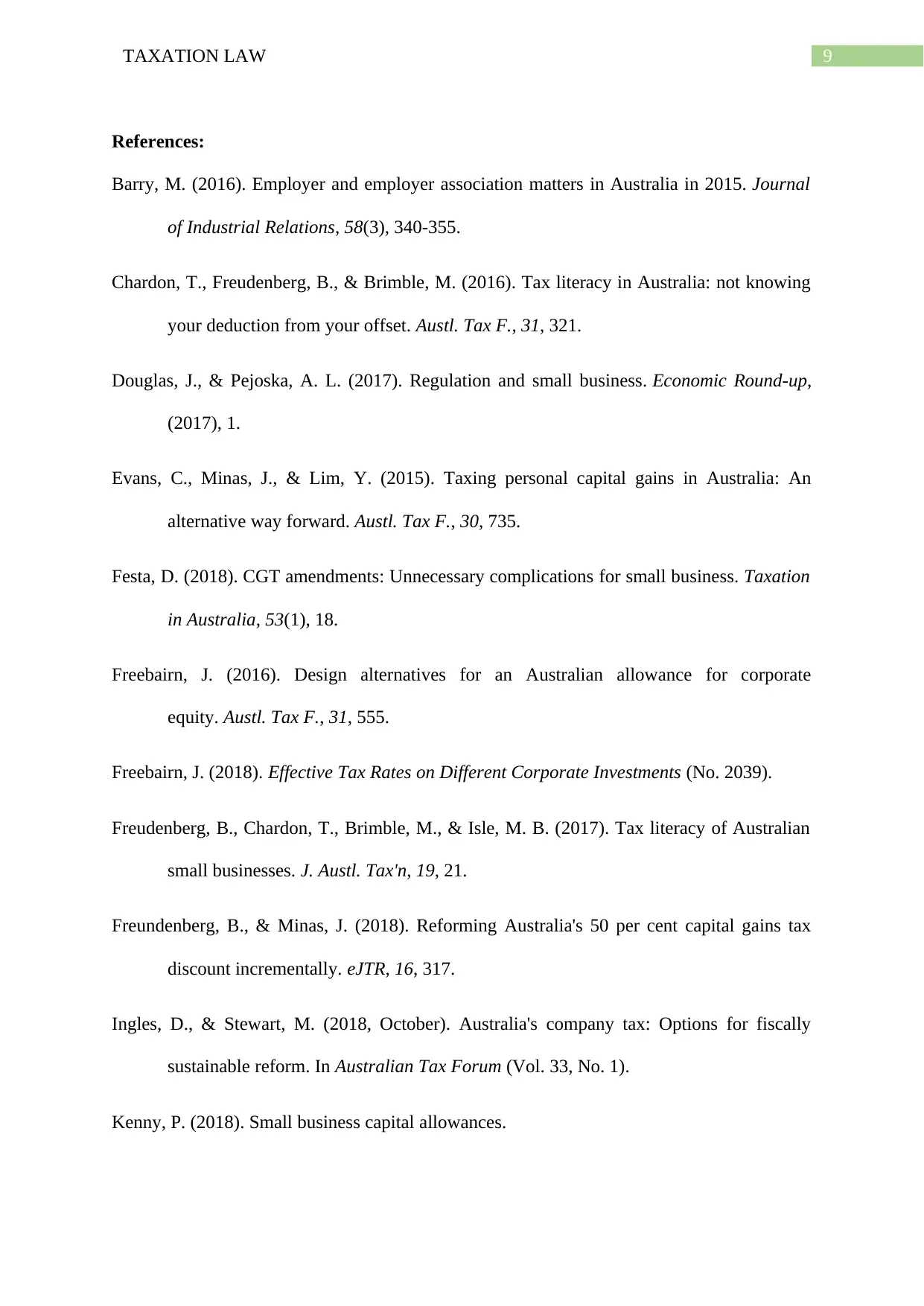
9TAXATION LAW
References:
Barry, M. (2016). Employer and employer association matters in Australia in 2015. Journal
of Industrial Relations, 58(3), 340-355.
Chardon, T., Freudenberg, B., & Brimble, M. (2016). Tax literacy in Australia: not knowing
your deduction from your offset. Austl. Tax F., 31, 321.
Douglas, J., & Pejoska, A. L. (2017). Regulation and small business. Economic Round-up,
(2017), 1.
Evans, C., Minas, J., & Lim, Y. (2015). Taxing personal capital gains in Australia: An
alternative way forward. Austl. Tax F., 30, 735.
Festa, D. (2018). CGT amendments: Unnecessary complications for small business. Taxation
in Australia, 53(1), 18.
Freebairn, J. (2016). Design alternatives for an Australian allowance for corporate
equity. Austl. Tax F., 31, 555.
Freebairn, J. (2018). Effective Tax Rates on Different Corporate Investments (No. 2039).
Freudenberg, B., Chardon, T., Brimble, M., & Isle, M. B. (2017). Tax literacy of Australian
small businesses. J. Austl. Tax'n, 19, 21.
Freundenberg, B., & Minas, J. (2018). Reforming Australia's 50 per cent capital gains tax
discount incrementally. eJTR, 16, 317.
Ingles, D., & Stewart, M. (2018, October). Australia's company tax: Options for fiscally
sustainable reform. In Australian Tax Forum (Vol. 33, No. 1).
Kenny, P. (2018). Small business capital allowances.
References:
Barry, M. (2016). Employer and employer association matters in Australia in 2015. Journal
of Industrial Relations, 58(3), 340-355.
Chardon, T., Freudenberg, B., & Brimble, M. (2016). Tax literacy in Australia: not knowing
your deduction from your offset. Austl. Tax F., 31, 321.
Douglas, J., & Pejoska, A. L. (2017). Regulation and small business. Economic Round-up,
(2017), 1.
Evans, C., Minas, J., & Lim, Y. (2015). Taxing personal capital gains in Australia: An
alternative way forward. Austl. Tax F., 30, 735.
Festa, D. (2018). CGT amendments: Unnecessary complications for small business. Taxation
in Australia, 53(1), 18.
Freebairn, J. (2016). Design alternatives for an Australian allowance for corporate
equity. Austl. Tax F., 31, 555.
Freebairn, J. (2018). Effective Tax Rates on Different Corporate Investments (No. 2039).
Freudenberg, B., Chardon, T., Brimble, M., & Isle, M. B. (2017). Tax literacy of Australian
small businesses. J. Austl. Tax'n, 19, 21.
Freundenberg, B., & Minas, J. (2018). Reforming Australia's 50 per cent capital gains tax
discount incrementally. eJTR, 16, 317.
Ingles, D., & Stewart, M. (2018, October). Australia's company tax: Options for fiscally
sustainable reform. In Australian Tax Forum (Vol. 33, No. 1).
Kenny, P. (2018). Small business capital allowances.
Paraphrase This Document
Need a fresh take? Get an instant paraphrase of this document with our AI Paraphraser
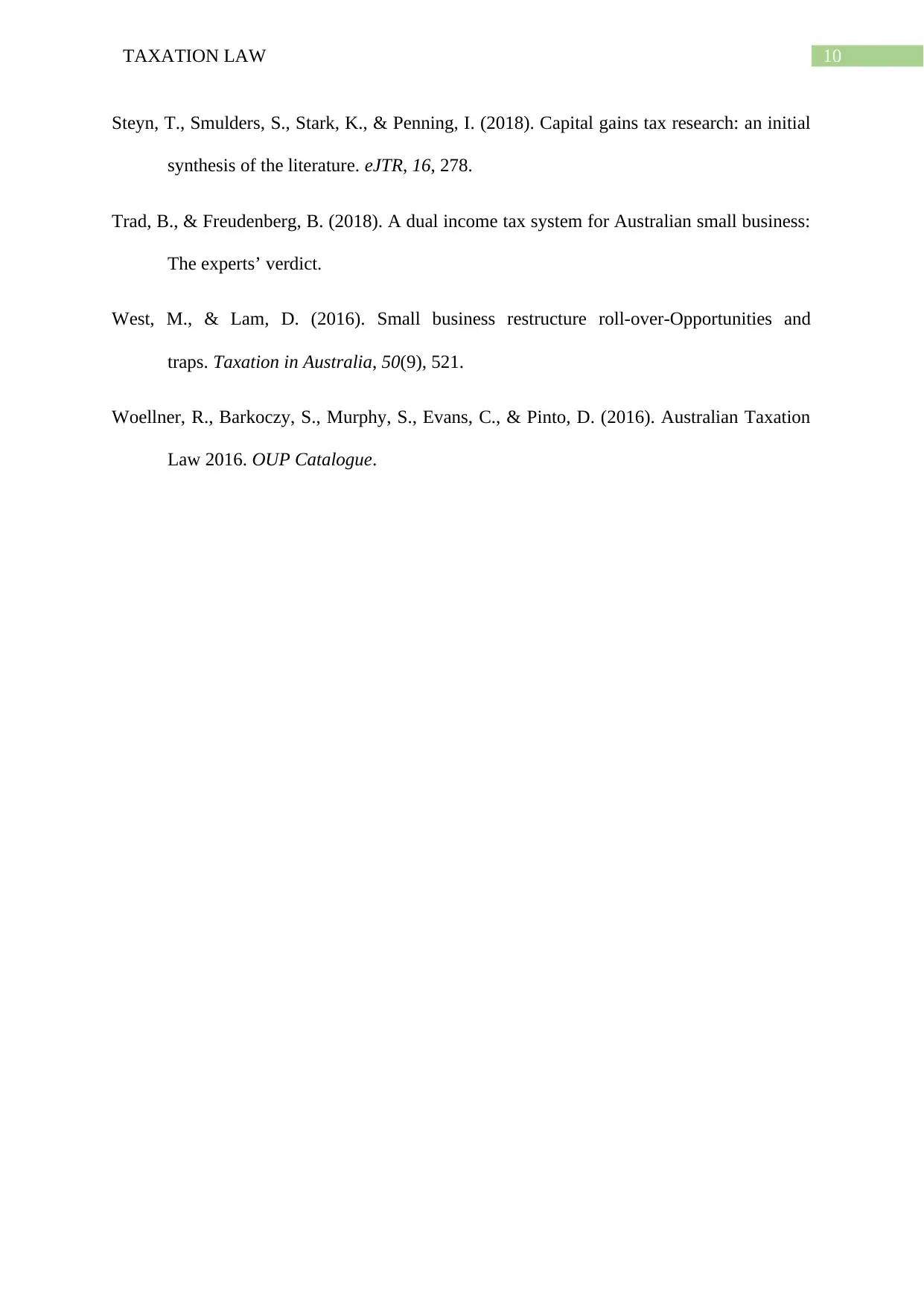
10TAXATION LAW
Steyn, T., Smulders, S., Stark, K., & Penning, I. (2018). Capital gains tax research: an initial
synthesis of the literature. eJTR, 16, 278.
Trad, B., & Freudenberg, B. (2018). A dual income tax system for Australian small business:
The experts’ verdict.
West, M., & Lam, D. (2016). Small business restructure roll-over-Opportunities and
traps. Taxation in Australia, 50(9), 521.
Woellner, R., Barkoczy, S., Murphy, S., Evans, C., & Pinto, D. (2016). Australian Taxation
Law 2016. OUP Catalogue.
Steyn, T., Smulders, S., Stark, K., & Penning, I. (2018). Capital gains tax research: an initial
synthesis of the literature. eJTR, 16, 278.
Trad, B., & Freudenberg, B. (2018). A dual income tax system for Australian small business:
The experts’ verdict.
West, M., & Lam, D. (2016). Small business restructure roll-over-Opportunities and
traps. Taxation in Australia, 50(9), 521.
Woellner, R., Barkoczy, S., Murphy, S., Evans, C., & Pinto, D. (2016). Australian Taxation
Law 2016. OUP Catalogue.
1 out of 11
Related Documents
Your All-in-One AI-Powered Toolkit for Academic Success.
+13062052269
info@desklib.com
Available 24*7 on WhatsApp / Email
![[object Object]](/_next/static/media/star-bottom.7253800d.svg)
Unlock your academic potential
Copyright © 2020–2025 A2Z Services. All Rights Reserved. Developed and managed by ZUCOL.





